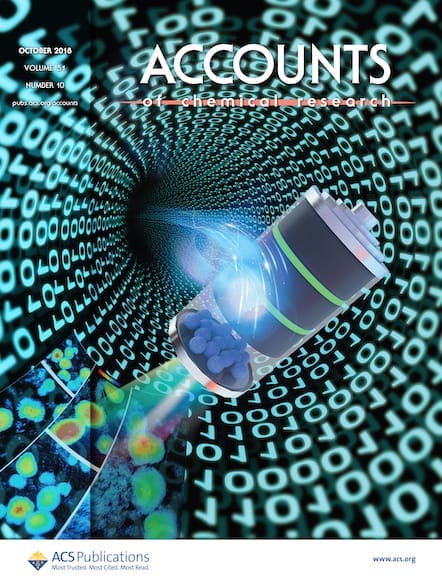Recently released citation metrics from Clarivate and Scopus show ACS Publications journals continue to be the most cited in chemistry. The 2021 Web of Science™ Journal Citation Reports™ from Clarivate showed our journals have a median two-year impact factor of 5.097, up 14% from last year’s report. Data from Scopus showed the average ACS Publications […]

Recently released citation metrics from Clarivate and Scopus show ACS Publications journals continue to be the most cited in chemistry. The 2021 Web of Science™ Journal Citation Reports™ from Clarivate showed our journals have a median two-year impact factor of 5.097, up 14% from last year’s report. Data from Scopus showed the average ACS Publications journal has a CiteScore of 10.6. Both of these independent metrics reflect citations within a defined number of years for articles published within a defined period.
Total citations, meanwhile, increased by more than 550,000. This represents a more than 15% increase across the portfolio. Citations grew from the previous year for every ACS Publications journal, as the number of articles published also increased to 58,974, and usage among ACS’ readers grew to almost 170 million article downloads.
As a result, ACS journals were named the most cited or the most impactful in 10 categories, including five of the seven main chemistry categories: Chemistry, Analytical; Chemistry, Inorganic & Nuclear; Chemistry, Medicinal; Chemistry, Multidisciplinary; and Chemistry, Organic.
Highlights from the latest Journal Citation Reports™ include:
- The Journal of the American Chemical Society (JACS), ACS’ flagship journal, remains the most-cited journal in chemistry with 609,263 total citations and a Journal Impact Factor™ of 15.419.
- Chemical Reviews remains the highest-impact journal in the Chemistry, Multidisciplinary category, with a Journal Impact Factor™ of 60.622, over 220,000 citations, and more than 6.3 million downloads.
- ACS Nano received a Journal Impact Factor™ of 15.881 and saw nearly 200,000 citations and over 8 million downloads.
- Accounts of Chemical Research achieved a Journal Impact Factor™ of 22.384.
- The Journal of Agricultural and Food Chemistry was once again the most-cited journal in the Agriculture, Multidisciplinary category with 144,020 total citations.
- With 156,738 citations, Analytical Chemistry was again the most-cited journal in the Chemistry, Analytical category.
- Inorganic Chemistry once again led the Chemistry, Inorganic & Nuclear category with 103,059 citations, and the Journal of Medicinal Chemistry remained the most-cited journal in the category of Chemistry, Medicinal with 85,946 citations.
- Crystal Growth & Design remained the most-cited journal in the Crystallography category with 33,973 citations.
- Organic Letters remained the most-cited in the Chemistry, Organic category with 107,262 citations.
- Macromolecules maintained its position as the most-cited journal in the Polymer Science category with 111,371 citations.
- Environmental Science & Technology remained the most-cited journal in both the Engineering, Environmental and Environmental Sciences categories, with a record 217,954 citations, outpacing competitor journals.
- ACS Central Science, ACS’ first fully open access journal, achieved a Journal Impact Factor™ of 14.553 with over 11,000 citations and over 2 million article downloads.
- ACS Omega’s Journal Impact Factor™ increased to 3.512, and the open access journal had over 23,000 citations, more than double the previous year.
To support additional applied materials research, ACS expanded its journal portfolio in this area, and several of these journals have received their first Journal Impact Factor™.
- ACS Applied Materials & Interfaces has retained its prominence in the field, with a Journal Impact Factor™ of 9.229 and 274,703 citations. Articles from the journal were downloaded more than 10.4 million times in 2020.
- ACS Applied Energy Materials nearly tripled its total citations, ending the year with 12,740.
- ACS Applied Electronic Materials has received a partial Journal Impact Factor™ of 3.314.
- ACS Applied Polymer Materials received a partial Journal Impact Factor™ of 4.089.
- ACS Applied Nano Materials achieved an inaugural Journal Impact Factor™ of 5.097.
- In our broader materials portfolio, ACS Materials Letters debuted with a partial Journal Impact Factor™ of 8.312, demonstrating how quickly the journal has gained prominence in its community.
Several journals established in the last 10 years also reported strong numbers in the recent report:
- ACS Catalysis, established in 2011, received a Journal Impact Factor™ of 13.084 and over 92,000 citations.
- ACS Macro Letters, established in 2012, achieved a Journal Impact Factor™ of 6.903 with 13,599 citations
- ACS Sustainable Chemistry & Engineering, established in 2013, received a Journal Impact Factor™ of 8.198 and 62,273 citations, a more than 50% increase from the prior year.
- ACS Energy Letters, established in 2016, saw its Journal Impact Factor™ rise to 23.101.
See Journal Metrics for Every ACS Publications Journal.
Want the latest stories delivered to your inbox each month?

Accounts of Chemical Research
Read our latest issue. Want to contribute to this journal?